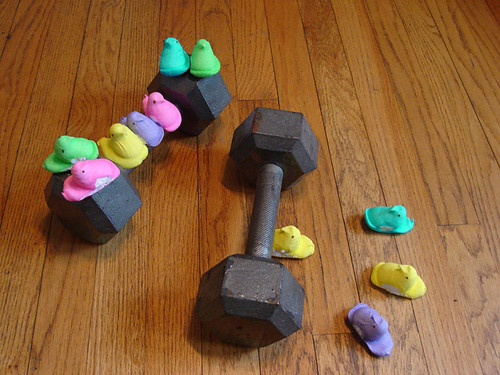tags: peeponaut, astropeep, marshmallow peeps, science, space travel, astronomy, Adler Planetarium
Astropeep strength training program, part of the selection process for identifying those marshmallow peeps who had "the right fluff". These special peeps would be recruited as peeponauts who would be sent into space on a weather balloon.
Like most scientists, I am a big fan of marshmallow peeps, which are my favorite experimental animals. So I was thrilled when a friend sent me an absolutely adorable story about a peeponaut -- that special marshmallow peep that acted as a mascot for a weather balloon that was launched by Chicago's Adler Planetarium recently, carrying some high school kids' scientific experiments into space.
"On any mission we like to use a video camera to document the flight," said astronomer Mark Hammergren. "And we said, if we have a video camera, and we have a Peep, why not video the Peep?"
This individual marshmallow peep mascot was chosen by the Adler Planetarium science team after a group of prospective peeponauts underwent extensive and rigorous psychological and physical training.
"We had to choose a Peep who had the right fluff," punned Hammergren shamelessly.
In addition to extensive training, the prospective peeponauts were subjected to a variety of space-like conditions, including extreme heat and cold, being attached to a spinning ceiling fan blade, and also enduring the rigors of a vacuum chamber.
This launch was Mission 12 of the Far Horizons program, which carried an experiment designed by two students from the Illinois Math & Science Academy. They wanted to measure how much brighter it is in space. To do this, the crew used a helium-filled weather balloon that carried the students' experiment -- and its peeponaut mascot -- until is is approximately 100,000 feet above the surface of the earth.
"At that altitude, it's 1 percent of the pressure [on the ground], the sky is black, you see the curvature of the Earth," remarked Geza Gyuk, the Adler's director of astronomy. "It's fantastic. You're 99 percent into space."
When the balloon is roughly 100,000 feet above the ground, it pops due to the lack of atmospheric pressure, and its payload -- experiment, camera, and astropeep -- parachutes back to earth.
The students were supported by the Adler crew, which consists of ten people who have been conducting a variety of science experiments with high school students for years.
The resulting video shows that everything did not go as smoothly as the student scientists and their ground crew hoped: the peeponaut experienced a few frightening moments when, after the balloon popped, the box containing the students' experiment nearly crushes the peeponaut, who dealt with this event with characteristic stoicism. After reaching the ground, the astropeep refused to answer reporters' questions.
"The Peep has been introspective since the flight," said Gyuk of the first marshmallow peep to ever enter space.
"And a little shriveled up," he added, somewhat uncharitably, of the sweet and brave (but dehydrated) space explorer.
Perhaps the reporters should have offered to talk to the peeponaut over beer, instead?
Read More About it:
Adler Planetarium Astro Science Workshop.
Adler' Planetarium's Astropeep recruiting program photoessay.
Chicago Tribune (quotes).
- Log in to post comments



And you eat them? *shakes head*
well, some people eat them, but i don't. eating them makes me ill.
but they make fun pets.
That characteristic stoicism is amazing, isn't it? I've seen it before. Solid. Unflappable. Calm in the most hectic crisis. Maybe we should send peeponauts on the next Mars mission.
Steff - Peeps are solid?!!!
Great find! I can't get enough of Peeps - at least, as long as i'm not required to eat them. Did you catch these hilarious Peep diaoramas recreating classic films?
Ian -- they're solid if you leave them out long enough. Peeps can become quite amazingly stale.
Oddly, some people prefer them that way.
They don't become stale. They "mature".